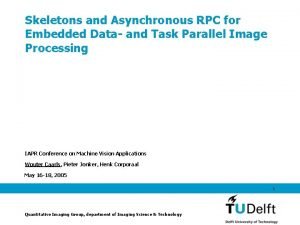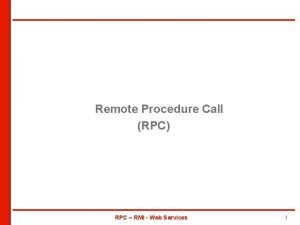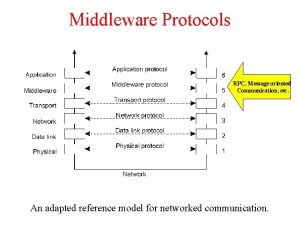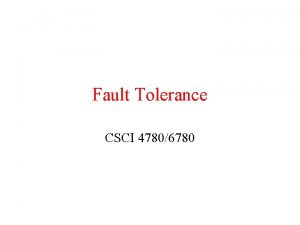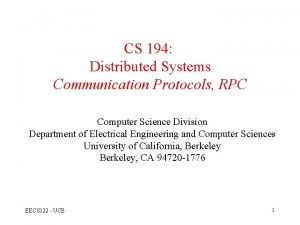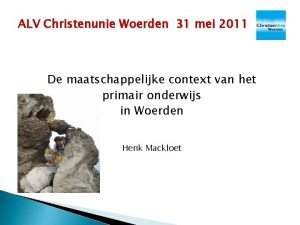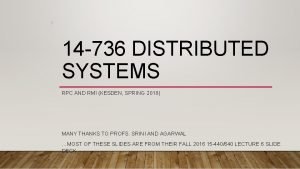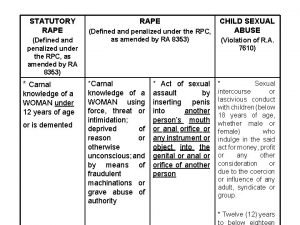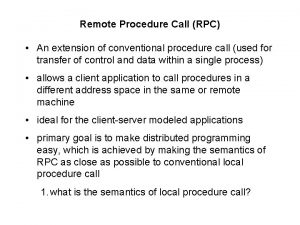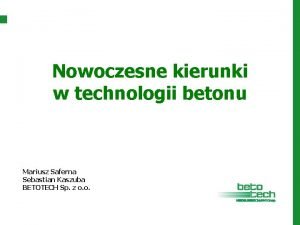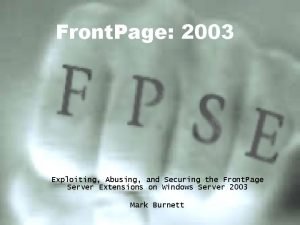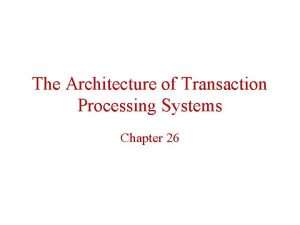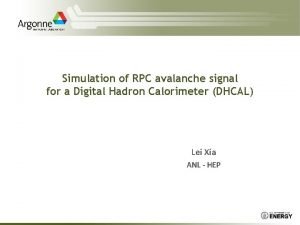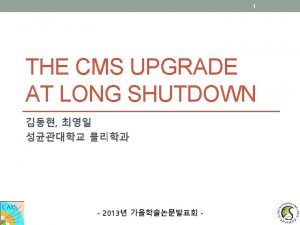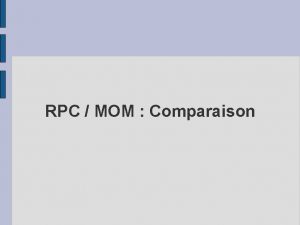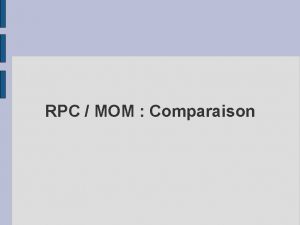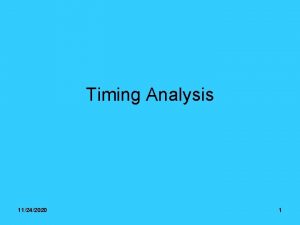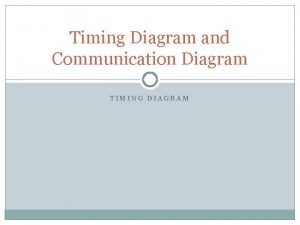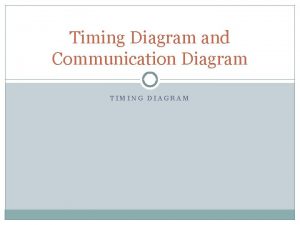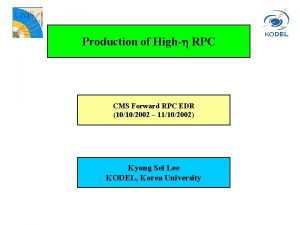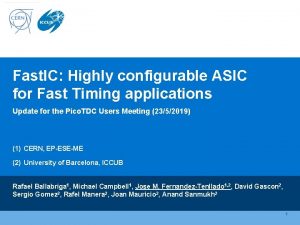New generation of high rate fast timing RPC



















- Slides: 19

New generation of high rate fast timing RPC for CMS muon upgrade Imad Laktineh On behlf of the CMS muon group

Outline v -CMS RPC upgrade project q High-rate i. RPC Ø Fast timing i. RPC o Conclusions

CMS RPC upgrade project To equip the RE 3/1 and RE 4/1† CMS muon stations with improved RPC chambers covering 1. 8<|η|<2. 4; each chamber spans 20° in φ; 1 layer per station RE 3/1 -RE 4/1: 72 chambers in all Two scenarios are proposed : -Double-gap RPC -Multigap RPC Using either glass or HPL as electrodes RE 3/1 Present RPC system: 1056 chambers (2 -gap HPL RPC) covering 0 < |η| < 1. 6 † RPC could potentially equip the RE 2/1 RE 4/ 1 3

CMS RPC upgrade is a part of the CMS muon upgrade project that proposes to equip the o high η muon stations with a new generation of detectors (i. RPC, GEM, FTM, . . ) to : q Increase muon system redundancy for |η|>1. 6, where background rates are largest q Improve muon reconstruction efficiency in offline data q Recover CSC inefficiencies in local reconstruction (stubs) in muon trigger phase 2 4

Requirements We expect 700 Hz/cm 2 in hottest points of RE 3/1 and RE 4/1(based on Fluka simulation) i. RPC should stand a particle rate up to 2 k. Hz/cm 2 (including a safety factor) RMS displacement @ p. T = 200 Ge. V gives ~2 -3 mm for RE 3/1 & RE 4/1 Readout granularity of few mm with digital mode 5

i. RPC high rate detection capability q Present CMS RPC chambers were certified up to 300 Hz/cm 2, irradiated with photons up to an integrated charge of 0. 05 C/cm 2, and a neutron fluence of 1012 n/cm 2 and equivalent dose of about 45 Gy was reached. q Rate capability of the RPC is related to the voltage drop in the resistive plate: ΔV = I R = q ρ d Φ Increase rate capability by reducing § electrode resistivity ρ: as low as the RPC principle still stands (> ~108 -109 Ωcm) low-resistivity HPL or doped glass (Tsinghua glass) § electrode thickness d: depends on electrode material easy for glass, possible for HPL § produced charge q : depends on gas mixture and number of gaps The less the charge produced, faster the eviction : beneficial also for chamber aging but this necessitates to increase FE electronics sensitivity 6

Electrode Resistivity and thickness q HPL/bakelite: Supplier : Puricelli Present system 1 -5 x 1010Ωcm, but ~0. 5 -1 x 1010Ωcm may be achievable; thickness down to 1 mm, typical CMS sizes are no problem Pressing units @ Puricelli q Low-resistivity glass: Supplier: Tsinghua U. associated company tunable resistivity, 1010Ωcm (or lower) achieved; no oiling procedure needed; no humidification of gas mixture; limited sizes only Glass Specifications: Present max. dimension: 32 cm× 30 cm Bulk resistivity: ≈1010. cm Standard thickness: 0. 5 mm--2 mm Thickness uniformity: 0. 02 mm Dielectric constant: ≈7. 5 -9. 5 Surface roughness: < 10 nm DC measurement: Ohmic behavior, stable up to 1 C/cm 2 1 k. V applied on a glass plate 32 days; integrated charge: 1 C/cm 2 7

HPL-based RPC Double-gap: gas gap = 1. 6 mm, HPL thickness = 2 mm performance studied with cosmic rays in presence of Cs source performance studied with muon beam in presence of Cs source at GIF++ Plastic RPC Cs-137 source Plastic max. γ rate ~1. 4 k. Hz/cm 2 Ø Shift @ ε=0. 95 in HV due to γ backgr. ~ 70 V Th = 110 f. C 8

Glass-based RPC single-gap RPC: gas gap = 1. 2 mm, glass thickness = 1 mm Small chamber : 30 x 30 cm 2; 1 x 1 cm 2 readout pads 150 Ge. V π, μ beam @ SPS, H 2 (Jun. 2015) Beam seen by one detector μ beam @ GIF++ H 2 (Jul. 2015) Ø 70% single-gap efficiency for low resist. GRPC @ > 2 k. Hz/cm 2 (i. e. >90% double-gap efficiency) 9

Towards Full-Size GRPC Gluing method: § Half size of RE 4/1 § Gluing small pieces of glass § Gluing zone <100μm Mechanical fixation method: § Half size of RE 4/1 § Mechanical fixation small pieces of glass § Separation distance of few mm; top and bottom gaps staggered § Gas tightness ensured by cassette Mechanical fixation method is more robust; issues regarding glue radiation hardness are absent ; less leakage current is observed 10

Towards Full-Size GRPC Gluing method: § Half size of RE 4/1 § Gluing small pieces of glass § Gluing zone <100μm Mechanical fixation method: § Half size of RE 4/1 § Mechanical fixation small pieces of glass § Separation distance of few mm; top and bottom gaps staggered § Gas tightness ensured by cassette Large detector built with low-resitivity glass was built and successfully tested at H 2 and will be soon exposed to GIF++ 11

FE Electronics q HARDROC ASIC is proposed to read the 2 -gap i. RPC q 64 -ch, Si. Ge technology, gain correction, 10 f. C-15 p. C q 3 thresh. levels, i. e. semi-analogue readout, will improve spatial resol. beyond digital readout ! 4. 7 mm testbench for the CALICE SDHCAL project 4. 3 mm q ~10 000 ASICs were already tested with a dedicated HARDROC 2 and 2 B: 160 pins q Successfully tested on both HPL and glass RPC; two kinds of PCB used: § Strips of 2. 5 mm pitch § Pickup pads of 1 cmx 1 cm . 12

Spatial Resolution GRPC telescope consisting of several low resist. Chamber (gas mixture 93% TFE, 5% CO 2, 2% SF 6), was used to test a 2 -gap GRPC with pickup strips @ PS, CERN, August 2014 HV = 7200 V Spatial resolution of ~1 -1. 5 mm achievable 13

Fast timing Multi-gap RPC is an excellent fast timing detector (ALICE). For CMS it could help to: Background mitigation Long lived neutrons are captured by nuclei γs : Photoelectric effect and Compton scattering few Me. V electrons leaving hits in RPC. These hits could corrupt the muon track reconstruction and increase trigger rate. Looking for correlated hits in time in the different MRPC stations one could get rid of many noisy hits. HSCP will get benefit of precise time information. d. E/d. X currently provided by the tracker is no more available in HL-LHC. 14

Thin dual bi-gap HPL (Bakelite) RPCs q Composed of two thin double-gap ( eq. 4 - gap RPC) § Using HPL electrodes thickness of (1. 5 mm) compared to the present CMS RPC (2 mm) and gap thicknesses (0. 5, 0, 8 mm) compared to the CMS RPC (2 mm) Operating HV = 6. 5 ~ 7. 0 k. V and 9. 1 ~ 9. 8 k. V for the 0, 5 and 0. 8 mm dual bi-gap respectively § Using lower threshold thanks to higher sensitive front end electronics (min. threshold ~ 20 f. C) §For 0. 8 mm Dual bi-gap RPC <qe> ~ 0. 6 p. C @ HVε=0. 95 = 9. 1 k. V Dual bi-gap RPC Th = 0. 60 m. V 72 Hz cm-2 1055 Hz cm-2 tested @ GIF++: Shift @ ε=0. 95 in HV due to ~ 1. 0 k. Hz cm-2 γ background ~ 100 V 15

Glass multi-gap RPC: Mosiac g. RPC q Multi-gap GRPC MRPC Component Honey Comb PCB Mylar Mosaic Glass Spacer Gap Prototype Mosiac GRPC Size (mm) 255× 472× 6 320× 540× 0. 7 260× 480× 0. 18 250× 470× 0. 7 & 250× 200× 0. 7 0. 5 0. 25× 5 q. ELBE @ HZDR (September 2015) § 30 Me. V e-beam § Gas: 90% TFE + 5% i-butane + 5% SF 6 Noise lower than 1 Hz/cm 2 Few electronic channels 16

Electronic readout for Multi-gap CMS-RPC FE electronics PETIROC : 32 -ch, Si. Ge, 0, 16 -400 p. C -32 trigger output -NOR 32_charge -NOR 32_time -global&individual threshold adjustment 20 ps resolution for Qinj >. 3 p. C Tsinghua TDC -TDC on FPGA (25 ps time resolution) developed by Tsinghua -TDC on ASIC (based on Vernier principle) aiming at better resolution, lower power consumption and more robustness Start Stop Slow Fast T 1 2 4 3 1 2 5 3 -- -- Ns-1 -- Nf-1 Ns Nf Same phase

-PCB pick-up strips read from both sides is being designed with the aim to achieve - Absolute time measurement Y On-detector Strip - Y-position determination (η position) Y= L/2 -v*(t 2 -t 1)/2. No need of η segmentation. (5 η segmentations are needed with the standard CMS electronics ) Strip Time difference of the two signals detected in channels 16 and 17 associated to two ends of the same strip. Off-detector Strip jitter rms (charges injected = 5 p. C) 16 0. 0347 18 20 0. 03162 0. 03355 22 0. 03445 24 0. 03479 26 0. 03567 28 0. 03467 30 0. 03443 32 strips of 3 mm width (4 mm pitch) Time resolution/channel ≈ 25 ps

Conclusions and prospects - New double-gap RPC detectors (glass and HPL) are able to stand the expected high rate fluences of the HL-LHC in the high η region of CMS muon stations (RE 3/1, RE 4/1) - New low-noise Front End electronics to achieve such performance is available and is being adapted to CMS running conditions - Fast timing could be an asset. Multi-gap RPC are the best detectors to achieve this. Low-jitters Front-End electronics equipped with TDC providing excellent time resolution is being developed and preliminary results are very encouraging. Simulation studies on trigger and trigger performance will allow to assess the interest of fast timing MRPC - Additional tests at CERN and elsewhere are planned to confirm the performance of the new detectors and to study their robustness within the CMS conditions
 Fast timing applications
Fast timing applications Fast effect timing chart
Fast effect timing chart Stahl
Stahl Lord you are good and your mercy endureth
Lord you are good and your mercy endureth Differentiate between acid fast and non acid fast bacteria
Differentiate between acid fast and non acid fast bacteria Acid fast vs non acid fast
Acid fast vs non acid fast Asynchronous rpc
Asynchronous rpc Rmi/rpc
Rmi/rpc Asynchronous rpc
Asynchronous rpc Rpc diagram
Rpc diagram Rpc semantics in the presence of failures
Rpc semantics in the presence of failures Rpc computer science
Rpc computer science Rpc woerden
Rpc woerden Rpc and rmi in distributed system
Rpc and rmi in distributed system Statutory rape rpc
Statutory rape rpc List some remote procedure call (rpc) issues.
List some remote procedure call (rpc) issues. Beton ductal
Beton ductal _vti_bin/_vti_adm/admin.dll exploit
_vti_bin/_vti_adm/admin.dll exploit Rpc implementation in distributed system
Rpc implementation in distributed system Avalanche rpc
Avalanche rpc






